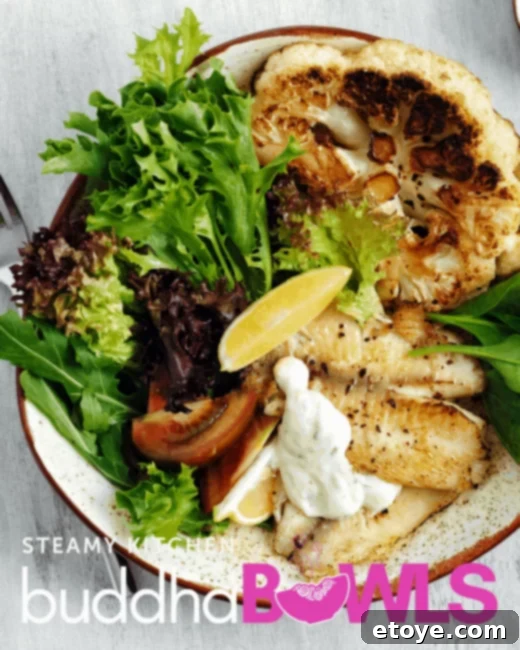Welcome to a culinary journey that celebrates vibrant flavors and wholesome ingredients! This delightful Buddha Bowl recipe features tender, easy-to-make roasted cauliflower “steaks” as its delicious centerpiece. Paired with flaky grilled fish, a refreshing bed of mixed greens, and a bright, simple dill dressing, all served over fluffy, lemony couscous, this meal is a symphony of textures and tastes designed to nourish and satisfy. It’s not just a meal; it’s an experience in balanced eating.
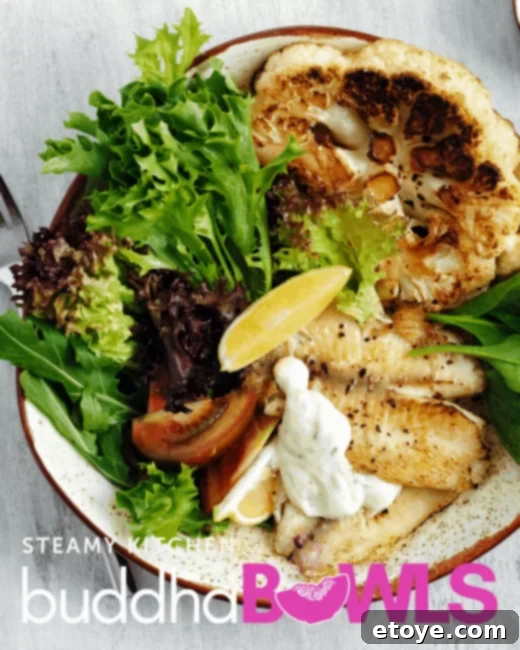
Discover the Delight of a Buddha Bowl

In today’s fast-paced world, finding meals that are both convenient and incredibly nutritious can be a challenge. That’s where the magnificent Buddha Bowl steps in! We’ve truly embraced the art of preparing simple, wholesome, and beautifully colorful one-bowl meals, and they’ve become a staple for healthy and sustainable eating in our kitchen.
At its core, a Buddha Bowl is a thoughtfully arranged single-bowl meal brimming with an assortment of nutritious foods. The charming name itself is said to originate from the bowl’s appearance: it’s typically packed so full of wholesome goodness that it creates a rounded, bountiful shape, reminiscent of the serene, rounded belly of Buddha. More than just a meal, it’s a philosophy of mindful eating, encouraging you to savor each ingredient and appreciate the harmonious combination.
The beauty of a Buddha Bowl lies in its customizable structure. It typically begins with a foundational base, which can be either a hearty grain or a fresh bed of leafy greens. On top of this, you generously pile in a variety of colorful vegetables, adding both flavor and essential nutrients. Next comes a lean protein source, providing sustained energy and satiety. Finally, the bowl is brought together with a flavorful, savory sauce or dressing, and often crowned with a sprinkle of something crunchy to add an irresistible textural contrast. This layered approach ensures every bite is interesting and satisfying.
Crafting Your Perfect Buddha Bowl: The Essential Components
To truly master the art of the Buddha Bowl, understanding its core elements is key. Think of it as a creative culinary canvas where you combine these vital components to build a meal that’s both balanced and bursting with flavor. Here’s a detailed breakdown of what makes a Buddha Bowl sing:
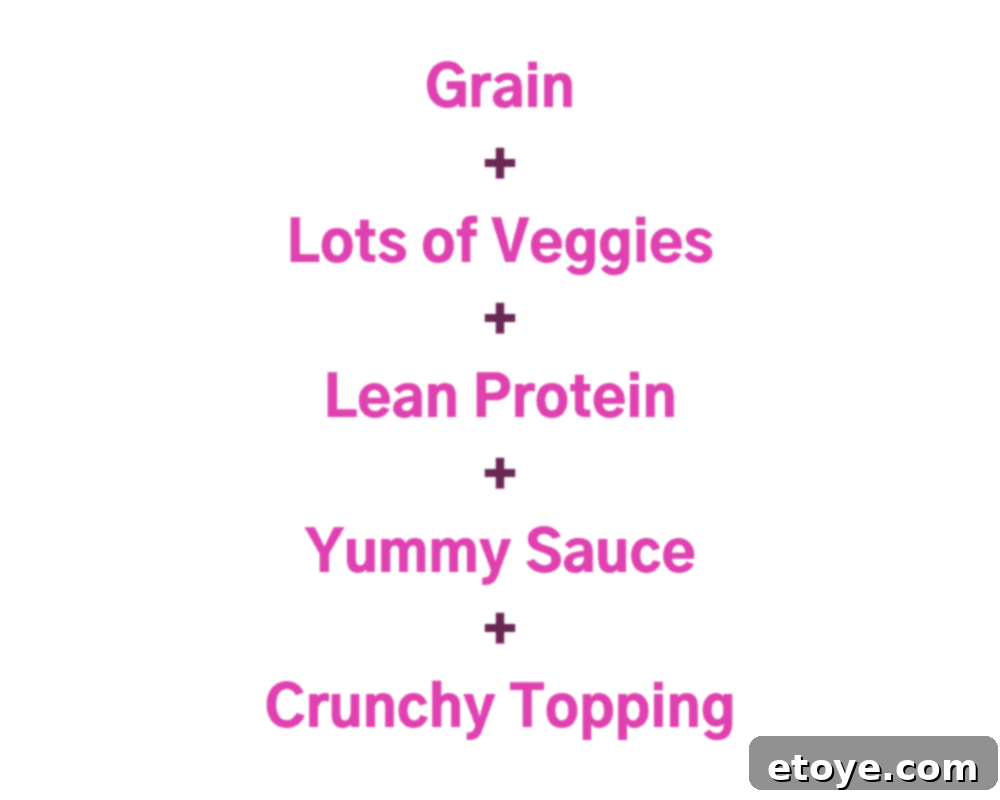
- For the Grains: The grain provides the nourishing foundation and grounding element of your bowl. For this particular recipe, we’ve chosen fluffy couscous. Its soft, pasta-like texture creates a wonderful backdrop, allowing our roasted cauliflower to truly shine with its nutty, subtly bittersweet character. Couscous is quick-cooking and absorbs flavors beautifully, making it an ideal choice. However, don’t feel limited! Other excellent grain options include brown rice for a chewier texture, quinoa for a complete protein boost, or even ancient grains like farro for added depth and fiber. The key is to select a grain that complements the other ingredients and provides satisfying substance.
- For the Vegetables: This is where your Buddha Bowl truly comes alive with color and nutrition. You’re in luck, because our star ingredient, cauliflower, is a fantastic vegetable that transforms into delightful “steaks” when roasted. We’ll guide you through the process of preparing these savory cauliflower steaks. Beyond the roasted cauliflower, we recommend adding a generous handful of fresh mixed salad greens. Their crisp, raw freshness offers a delightful contrast to the tender, drier texture of the roasted cauliflower. Feel free to expand your vegetable palette with anything from shredded carrots, sliced cucumbers, bell peppers, or even steamed broccoli florets. The more varied the vegetables, the wider the spectrum of vitamins and minerals you’ll enjoy.
- For the Protein: A good protein source ensures your Buddha Bowl keeps you feeling full and energized. For this recipe, we suggest grilling or baking fresh fish fillets. Lemon is a dominant flavor here, so any fish that pairs well with citrus, such as cod, salmon, or tilapia, would be an excellent choice. If you have leftover cooked fish, that’s even better for a quick assembly! For those looking for alternatives, consider canned sardines for a robust flavor and omega-3 boost, or explore plant-based options like baked tofu, roasted chickpeas, or lentils. The goal is a lean, wholesome protein that complements the overall flavor profile.
- For the Sauce: The sauce is the magical element that ties all the individual components of your Buddha Bowl together, infusing everything with cohesive flavor and moisture. We’ll show you how to prepare a creamy dill dressing that is both refreshing and incredibly flavorful. This dressing enhances the natural tastes of the vegetables and fish while adding a luscious texture. For those who prefer a non-creamy option, we’ll also provide an equally easy and delicious vinaigrette-style dill dressing. A good sauce elevates the entire dish from a collection of ingredients to a harmonious meal.
- For the Crunch: Don’t underestimate the power of texture! Adding a crunchy element provides a delightful contrast that makes each bite more interesting and satisfying. For simplicity and maximum flavor, we recommend a sprinkle of chopped toasted almonds. Their earthy notes and crisp texture are perfect. Other fantastic options include toasted croutons for a classic touch, pumpkin seeds, sunflower seeds, or even a handful of crispy fried onions. It’s hard to go wrong with this component – just pick something that adds that satisfying snap!
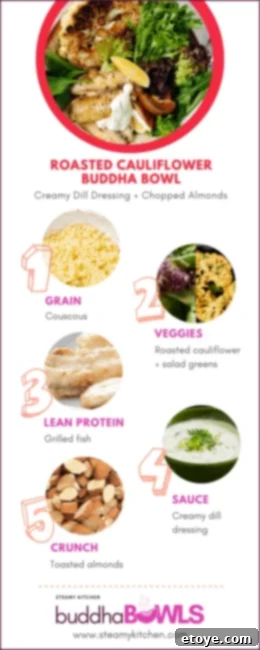
A Deep Dive into Couscous: Your Grain Foundation
Couscous, a staple in North African and Middle Eastern cuisine, is a delightful and versatile grain that makes for an excellent base in any Buddha Bowl. Despite often being mistaken for a grain, it’s actually a type of pasta made from semolina wheat. Its quick cooking time and ability to absorb flavors make it a favorite. When you’re out shopping, you’ll most likely encounter three main varieties of couscous, each with its own characteristics:
- Moroccan Couscous: This is the smallest in size, resembling tiny granules. It’s incredibly fast to prepare, typically cooking in about 5-10 minutes. You might often see it labeled as “instant couscous” due to its quick preparation. Its delicate texture is perfect for absorbing dressings and complementing other ingredients without overpowering them.
- Israeli Couscous (Ptitim): Also known as pearl couscous, this variety features pellets about the size of peppercorns. It has a chewier, more substantial texture than Moroccan couscous and usually takes a bit longer to cook, around 10-15 minutes. Toasting Israeli couscous before cooking can enhance its nutty flavor and slightly reduce cooking time, offering a more robust base for your bowls.
- Lebanese Couscous (Moghrabieh): This is the largest type, with granules often the size of small peas. It boasts the longest cooking time, typically requiring 15-20 minutes, and has a wonderfully chewy and hearty texture. Lebanese couscous can stand up to richer sauces and makes a very satisfying meal.
A quick comparison of different finished couscous dishes, showcasing the varied textures and sizes:
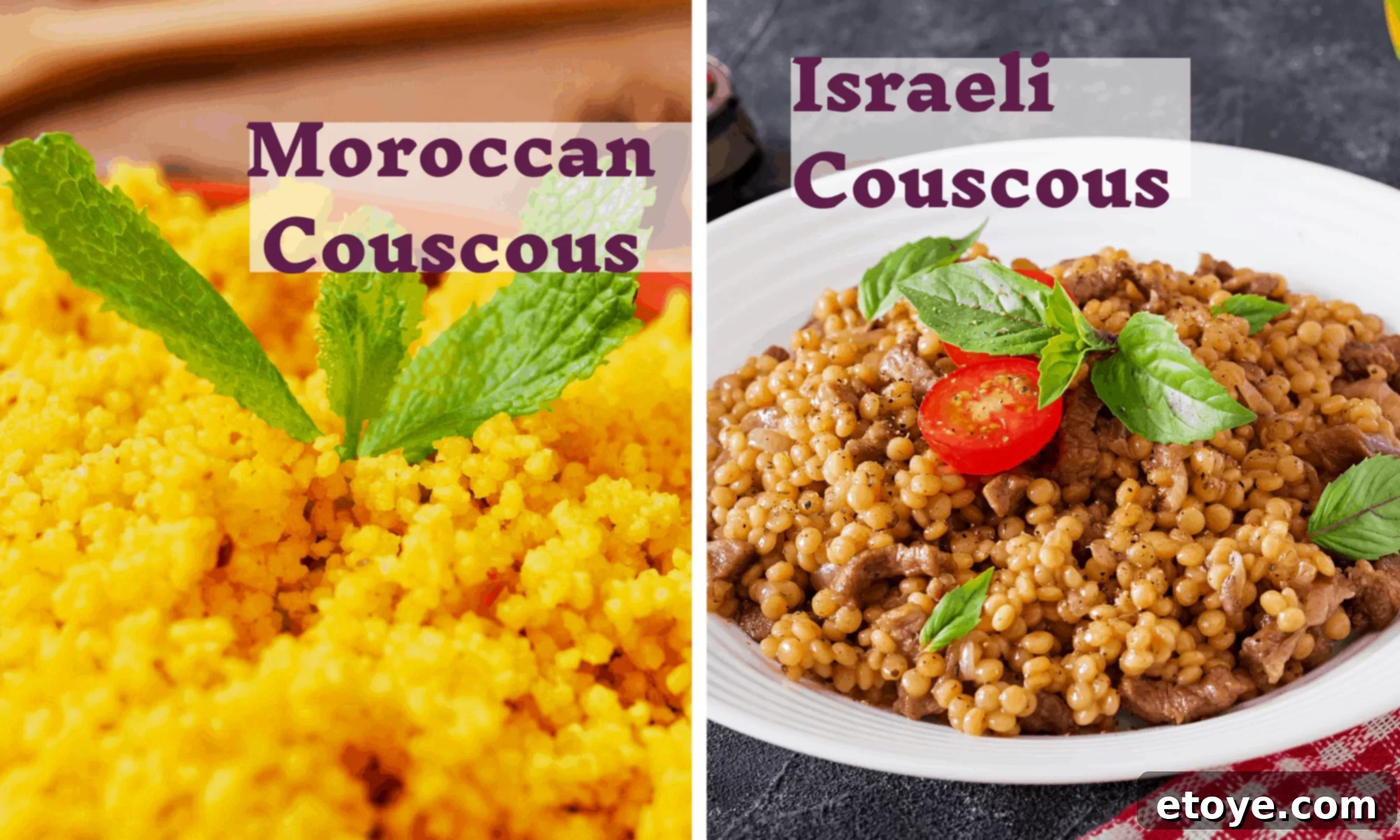
For the sake of ultimate ease and simplicity in this recipe, we’ll be defaulting to the quick-cooking Moroccan couscous. Its fine texture and speed make it perfect for busy weeknights, allowing you to get a delicious and healthy meal on the table in no time. If you’re curious to explore other options, you can find a quick and easy recipe for Israeli couscous here.
Regardless of the variety you choose, a general rule of thumb for cooking couscous is to use 1 1/4 times the amount of liquid (water or broth) for every cup of dry couscous. This ratio ensures perfectly fluffy, tender grains every time.
- To begin, bring your chosen liquid to a rolling boil in a pot. Add just a pinch or two of salt to enhance the flavor of the couscous.
- Once the water is boiling, stir in the dry couscous. Immediately cover the pot with a tight-fitting lid and remove it from the heat. The magic of couscous is that it steams to perfection off the heat!
- Allow the couscous to steam undisturbed for 5 to 10 minutes, or until all the liquid has been absorbed and the grains are tender and fluffy. If you notice it getting too dry before it’s fully cooked, add a splash more water.
- When ready, use a fork to gently fluff the couscous, separating any grains that might have clumped together. For an extra burst of freshness and aroma, stir in some lemon zest if you wish. Hint: Keep that lemon handy, as its bright flavor will be a recurring theme throughout the rest of this delicious recipe!
Mastering the Art of Roasting Cauliflower Steaks
Roasted cauliflower “steaks” are an incredible way to enjoy this versatile vegetable, giving it a hearty, satisfying texture and a deliciously nutty flavor. They make an excellent main component in our Buddha Bowl, offering a plant-based alternative to traditional steaks, yet with a wonderful depth of flavor. Here’s how to prepare them perfectly:
Start with a whole head of cauliflower. Carefully slice it lengthwise through the core to create a couple of large, thick slabs, about 1-inch thick. These substantial pieces are what we lovingly refer to as “steaks.” Keeping the core intact helps hold the “steaks” together during cooking, ensuring they remain firm and easy to handle.
Next, prepare a flavorful marinade or brush for your cauliflower. In a small bowl, whisk together olive oil, fresh lemon juice (continuing our lemon theme!), minced garlic, a pinch of red pepper flakes for a subtle kick, and generous seasoning of sea salt and freshly ground black pepper. Feel free to customize this with your favorite herbs or spices – smoked paprika, cumin, or dried oregano would also be fantastic additions. Remember to choose seasonings that won’t burn easily during roasting.
Generously brush each cauliflower “steak” on both sides with this flavorful mixture. You can coat them fully now, ensuring every crevice is saturated with flavor, or you can brush more on halfway through the cooking time for an extra layer of seasoning. Arrange your coated cauliflower steaks in a single layer on a parchment-lined baking sheet. Parchment paper prevents sticking and makes cleanup a breeze.
Roast the cauliflower in a preheated oven at 400 degrees F (200 degrees C) for 30 to 35 minutes, or until the edges are beautifully golden brown and caramelized, and the center is tender when pierced with a fork. Flipping them halfway through the cooking process ensures even browning and tender texture on both sides. While your cauliflower is roasting to perfection, you’ll have ample time to prepare the other components of your Buddha Bowl.

Crafting the Irresistible Creamy Dill Dressing
No Buddha Bowl is complete without a stellar dressing to bring all the flavors together, and our creamy dill dressing does just that. It’s light, refreshing, and incredibly versatile, highlighting the fresh, zesty notes we love. Remember those supporting characters for the cauliflower – the lemon and garlic? It’s encore time! We’re bringing most of them back to create this wonderfully light yet creamy yogurt-based dressing. The yogurt provides a lovely tang and smooth consistency, while fresh dill infuses it with herbaceous brightness.
To make this delightful dressing, simply combine the following ingredients in a small bowl:
- 1/2 cup plain yogurt (Greek yogurt for extra thickness, or regular for a lighter texture)
- 1 clove garlic, finely minced (or more, to your taste)
- 2-3 tablespoons fresh dill, finely chopped (the fresher, the better!)
- A generous squeeze of fresh lemon juice (adjust to your desired tartness)
- 3 tablespoons extra virgin olive oil
- A pinch of sea salt and freshly ground black pepper to taste
Whisk all the ingredients together until well combined and smooth. If the dressing is too thick for your liking, you can thin it out with a tablespoon or two of water until it reaches a pourable consistency. This dressing is incredibly forgiving, so feel free to play with the proportions to suit your palate.
Feel free to get creative with other fresh herbs you prefer – basil, chervil, chives, cilantro, or parsley would all be fantastic additions, individually or in combination. Don’t be shy about adding heaps more herbs for an extra burst of freshness! This dressing can be stored in an airtight container in the refrigerator for 2-4 days, making it perfect for meal prepping.
But what if you’re avoiding dairy or eggs? No worries! For a quick and easy vegan version that’s just as delicious, try this simple formula:
- A generous handful of fresh dill, finely chopped
- 1 garlic clove, roughly chopped
- 1 1/2 tablespoons apple cider vinegar (or red or white wine vinegar for a different tang)
- 1 teaspoon Dijon mustard (acts as an emulsifier and adds depth)
- 5-6 tablespoons mild olive oil (use a good quality oil for the best flavor)
- Sea salt and freshly ground black pepper to taste
- A pinch of sugar if needed (to balance the acidity of the vinegar)
Simply blend these ingredients until smooth and creamy. For more homemade dressing ideas, be sure to check out Four Essential Homemade Salad Dressings.
Further Inspirations for Your Buddha Bowl Journey
The beauty of the Buddha Bowl concept lies in its endless adaptability. While our Roasted Cauliflower Buddha Bowl is a fantastic starting point, we encourage you to explore and personalize your meals. Here are some resources and ideas to inspire your culinary creativity, helping you build a repertoire of delicious and nutritious one-bowl wonders:
Explore More Grains:
Expand your knowledge and introduce new textures to your bowls:
- Learn more about the history and versatility of couscous with this guide: What is Couscous?
- If you’re ready to try a different variety, master the art of cooking larger pearl couscous: How to Cook Israeli Couscous
Vary Your Veggies:
Cauliflower is fantastic, but don’t stop there! Discover other ways to prepare your vegetables:
- For an even heartier cauliflower dish, try a robust version: Roast Cauliflower Recipe with Bacon and Garlic
- Explore a classic take on our star vegetable component: Roasted Cauliflower Steaks
Switch Up Your Protein:
While grilled fish is a perfect complement, there are many other excellent protein options:
- Discover a simple and clean way to cook your fish: Baked Fish in Parchment
- For a burst of fresh flavor, try this recipe for succulent fish: Grilled Fish with Citrus Herb Crust

Roasted Cauliflower Buddha Bowl Recipe with Dill Dressing
★
★
★
★
Pin Recipe
⏱️
15
30
🍴
Main Course
Mediterranean
👥
4
581
kcal
Ingredients
For the Vegetables:
- 2 1/2 tablespoons cooking oil
- 1 tablespoon lemon juice
- 2 cloves garlic, crushed
- 1 pinch red pepper flakes
- Sea salt and freshly ground black pepper
- 1 large head cauliflower stem on, sliced lengthwise into 4 “steaks”
- 2-4 cups mixed salad greens or other raw vegetables
For the Grain:
- 2 1/2 cups water or broth
- 1 1/2 cups Moroccan couscous
- Salt to taste
- Lemon zest optional
For the Protein:
- 4 fillets cooked fish
For the Dressing:
- 1/2 cup plain yogurt
- 1 clove garlic, minced
- 2-3 tablespoons chopped dill
- Squeeze of lemon juice
- 3 tablespoons olive oil
- Sea salt and freshly ground black pepper
- Water as needed
For the Crunch:
- ½ cup toasted almonds, chopped or slivered almonds
Instructions
- Preheat the oven to 400 degrees F (200 degrees C).
- Mix oil, lemon juice, garlic, red pepper flakes, salt, and pepper together. Coat each cauliflower “steak” on both sides with the mixture. Transfer steaks onto a lined baking sheet.
- Roast in the preheated oven until golden and fork-tender, flipping halfway, 30 to 35 minutes.
- Meanwhile, bring water to a boil in a pot and add salt. Stir in couscous, cover with a lid, and remove pot from heat. Let steam until couscous is tender, 5 to 10 minutes. Fluff grains with a fork if they stick together and season with lemon zest if desired.
- Whisk the dressing ingredients together, adding 1 tablespoon of water at a time to thin it out into a pourable consistency.
- To assemble the bowls, divide couscous among 4 large bowls. Top each with a cauliflower steak, a fillet, and a handful of greens. Drizzle dill dressing over the bowl and top with almonds. Garnish with any extra dill or lemon zest.
Notes
Nutrition
Calories:
581
kcal
Carbohydrates:
68
g
Protein:
18
g
Fat:
28
g
Saturated Fat:
3
g
Cholesterol:
4
mg
Sodium:
98
mg
Potassium:
943
mg
Fiber:
10
g
Sugar:
6
g
Vitamin A:
273
IU
Vitamin C:
108
mg
Calcium:
156
mg
Iron:
2
mg
🔍
buddha bowl, buddhabowl, roasted cauliflower, healthy recipes, dill dressing, grilled fish
Tried this recipe?
Let us know how it was!
